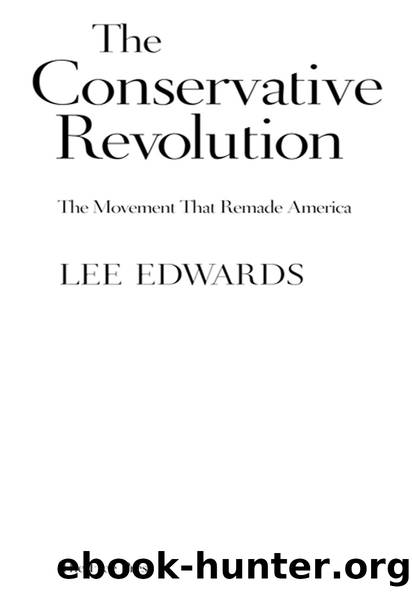The Conservative Revolution by Lee Edwards

Author:Lee Edwards
Language: eng
Format: epub
Publisher: Free Press
Published: 1999-08-14T16:00:00+00:00
Chapter 11
Winning Conservative
THE PRESIDENCY OF JIMMY CARTER WAS A TIME OF ECONOMIC MISERY FOR the American people and of communist gains around the world. But they were golden days for conservatives. Following Watergate, Republicans had been told—and many believed—that their party was finished. But in the 1978 off-year elections, after just two years of Carter, the GOP gained three seats in the Senate and thirteen seats in the House of Representatives, almost all of them conservatives. America was not interested in abandoning its two-party system.
Because of Carter’s ineffectiveness, things got even better for conservatives in the next two years. By the end of 1979, the inflation rate stood at 13.3 percent—the highest since the Korean War and nearly double the 7.2 percent that Carter had inherited from Gerald Ford on his election in 1976. Confronted by mounting economic woes, Carter refused to blame himself or his administration’s maladroit decisions. Instead, he faulted the American people, who, he said, were deep in the throes of a spiritual “crisis of confidence.”1 They were also being slowly strangled by “stagflation”—double-digit inflation coupled with zero economic growth.
Things were no better abroad. The pro-West shah of Iran was ousted, Marxist regimes were established in Angola and Mozambique, and the Soviets invaded Afghanistan. Casting about for an explanation of communism’s global aggression, Andrew Young, Carter’s ambassador to the United Nations, went Orwellian, asserting that the thirty thousand Cuban troops in Angola brought “a certain stability and order” to the country.2
What better time for a conservative to run for president?
Ronald Reagan was eager to declare his candidacy in 1980, in contrast to his more cautious course in 1975. Then he had hesitated to challenge incumbent President Ford. A turning point for Reagan was Ford’s refusal in July 1975 to meet with famed Russian dissident and author Alexander Solzhenitsyn. In his syndicated column, Reagan ridiculed the reasons given: the president had to attend a party for his daughter; the Russian writer had not formally requested a meeting; it was not clear “what [the president] would gain by a meeting with Solzhenitsyn.” Reagan made it clear that a President Reagan would have been honored to sit down with the famed survivor and chronicler of the Gulag Archipelago.3
Formally announcing that he was a presidential candidate in November 1975, Reagan soon headed north to New Hampshire, site of the first primary. He was the early favorite with the enthusiastic backing of Governor Meldrim Thomson, publisher William Loeb of the Manchester Union-Leader, and other key conservatives in the state.
But the Ford people shrewdly zeroed in on a Reagan proposal to transfer some $90 billion worth of federal programs to the states, including education, public housing and community development, revenue sharing, and certain health and welfare programs. Ford operatives charged that state and local tax rates would have to be hiked to cover the cost of the transferred programs. At the same time, there were suggestions (echoing the anti-Goldwater, anticonservative rhetoric of 1964) that if he were elected president, Reagan would slash social security, veterans’ benefits, and other welfare programs.
Download
This site does not store any files on its server. We only index and link to content provided by other sites. Please contact the content providers to delete copyright contents if any and email us, we'll remove relevant links or contents immediately.
Einstein: His Life and Universe by Walter Isaacson(1965)
Finding Freedom: Harry and Meghan and the Making of a Modern Royal Family by Omid Scobie & Carolyn Durand(1353)
Promised Land (9781524763183) by Obama Barack(1314)
Finding Freedom by Omid Scobie(1252)
Compromised by Peter Strzok(1229)
JFK by Fredrik Logevall(1126)
Freedom by Sebastian Junger(813)
The Russia House by John Le Carré(781)
Salford Lads: The Rise and Fall of Paul Massey by Bernard O'Mahoney(734)
The Irish Buddhist by Alicia Turner(715)
Day of the Dead by Mark Roberts(714)
Kremlin Winter by Robert Service(682)
A World Ablaze by Craig Harline(678)
Graveyard (Ed & Lorraine Warren Book 1) by Ed Warren & Lorraine Warren & Robert David Chase(678)
Joe Biden: American Dreamer by Evan Osnos(648)
Flying Tiger by Samson Jack(635)
Melania and Me: The Rise and Fall of My Friendship With the First Lady by Stephanie Winston Wolkoff(614)
100 Things Successful Leaders Do by Nigel Cumberland(611)
The Mission by David W. Brown(593)
